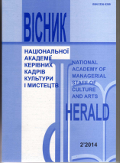SYMBOLS OF THE HOSPITALITY IN THE FESTIVE AND CEREMONIAL CULTURE
DOI:
https://doi.org/10.32461/2226-3209.2.2014.137959Keywords:
symbol, hospitality, ceremony, celebration, tradition, festive and ceremonial culture, bread, saltAbstract
The article discusses the symbolism of the hospitality in the festive and ceremonial culture. It is emphasized that the mentioned symbolism contributes to the integration of the society and the establishment of the trust between its members, certainly suggesting the reciprocity of the feelings and mutual need for the gratitude. The functioning of the tradition of the hospitality in the accordance with the requirements of the universal morality is substantiated.
The traditional rules of human society (the respect, reverence and compassion, kindness, hospitality, etc.) are the basis of the moral culture of the communication. The hospitality as a cultural-historical phenomenon is primarily based on the Christian principle of the love to the God and the close people. It is well-established for the centuries folk tradition with love and respect the guests to accept and regale. Hospitality is organically linked with the festive ceremonial culture of the Ukrainian people, and, therefore, with its multifaceted ritualization lifestyle.
The rite is the traditional unproductive, conditional symbolic actions. It accompanies the social sanctioning important life moments of the individual or the human collective. The holiday as a ritual function as the necessary moments of the social life, specifically declaring and claiming ideas, ideals, moral standards of the behaviour and world cultural values of the human community.
The marital life of the Ukrainians for centuries is accompanied by the numerous rites and rituals that by its shaped symbolism fixed the nodal stages of the human life, which was obligatory to invite the guests, or they came themselves. The result was a complex branched family and domestic rituals, distinguished by their quality characteristics.
The sociocultural symbolism legally qualify as a spiritual core and distinctive building material of the rite as its components clearly embody the most important ritual actions affecting the sensual sphere of the consciousness of their creators and participants and largely programmes the educational impact of the newly created festivals and rituals. Ceremonial symbol not only inform, but also organizes, brings the emotional and volitional capacity of the man to the brink where begin the spiritual actions.
The arable land, grain and bread baked from it acquired the sacred force of our ancestors. Borrowed from the paganism, they remain an important ritual significance in the Orthodox rites. And today we see on the Ukrainian table the Christmas kutya, Easter cake, wedding ceremony etc. Handing the round loaf to the honored guests is an integral component of the modern Ukrainian diplomatic protocol.
The salt in the moral and ethical context symbolizes the life's challenges, the tests of the loyalty and friendship, and is often used in the domestic rites as "salt – a holy cause" in the organic unity with the bread. The congratulations with bread and salt the arrived guest was an integral component of the traditional etiquette since the days of medievalRussia. Believed that in this way you can make friends even sworn enemies.
The Ukrainian house was wide open to every traveller, visitor or a beggar, but the conditions of the visit are quite strictly regulated. For example, it was not accepted to go visiting during field works. Not frowned upon coming to visit on weekdays – then the relatives or neighbours were visited only on economic matters, ritualization of the reception the guest simplifies greatly. However, with well-established rule of the reception even in normal case was obligatory to invite to enter the house "at least for a moment".
The guest must cross the threshold, showing the respect for the family members and their deceased ancestors, which on the popular belief continued to live together with the living. At the dinner table, after having covered it with a tablecloth and served the bread and salt, the welcome guest was generously regaled; it was accepted to submit grape wine – "at least one glass" in the southern regions of theUkraine.
Thus, it is concluded, that the developed system of the national calendar rites was long designed to promote the material and spiritual state of the family. For the centuries by means of the holidays and ceremonies the older generations passed on his love to labour, freedom, hospitality and life optimism for the young.
Certainly the hospitality is a mutual, in fact – it is a human need for gratitude – a system of the stereotyped forms which express the various aspects of the communication. Ethnocultural painted symbols of the hospitality promote traditionally the integration of the society and the establishment of the trust between even historically and geographically distant from each other peoples. The tradition of hospitality cultivated the desire to receive guests with the respect and to regale them in the accordance with the requirements of the universal morality.
Downloads
Published
Issue
Section
License
Authors who publish with this journal agree to the following terms:
1. Authors retain copyright and grant the journal right of first publication with the work simultaneously licensed under a Creative Commons Attribution License that allows others to share the work with an acknowledgement of the work's authorship and initial publication in this journal.
2. Authors are able to enter into separate, additional contractual arrangements for the non-exclusive distribution of the journal's published version of the work (e.g., post it to an institutional repository or publish it in a book), with an acknowledgement of its initial publication in this journal.
3. Authors are permitted and encouraged to post their work online (e.g., in institutional repositories or on their website) prior to and during the submission process, as it can lead to productive exchanges, as well as earlier and greater citation of published work (See The Effect of Open Access).


